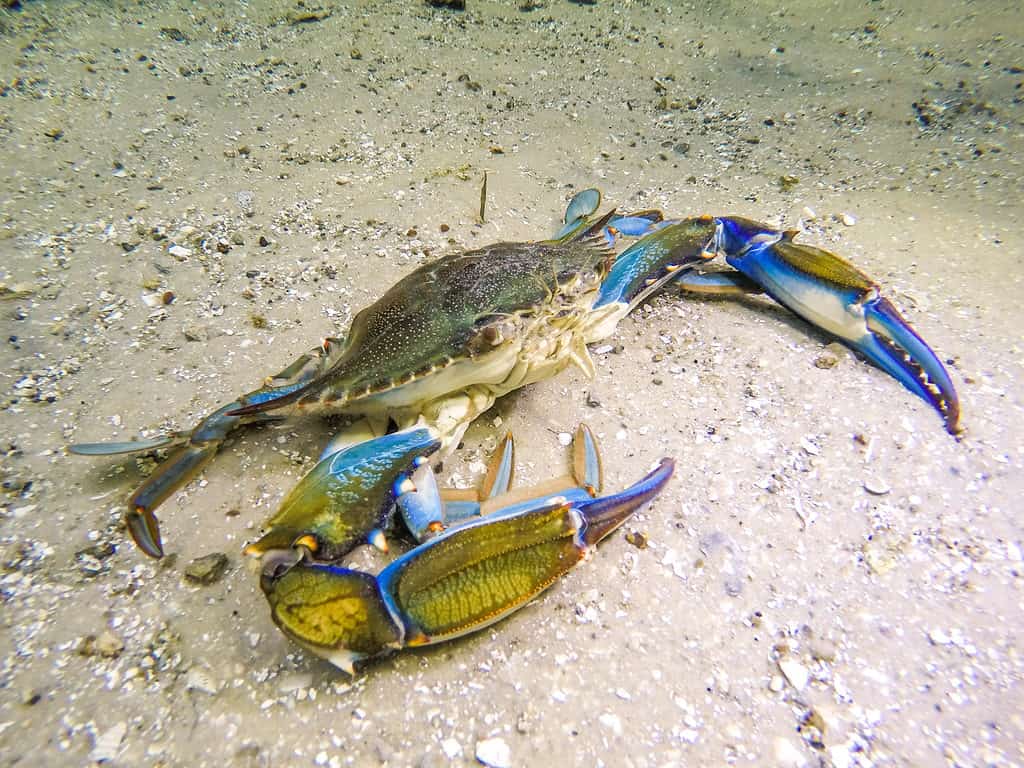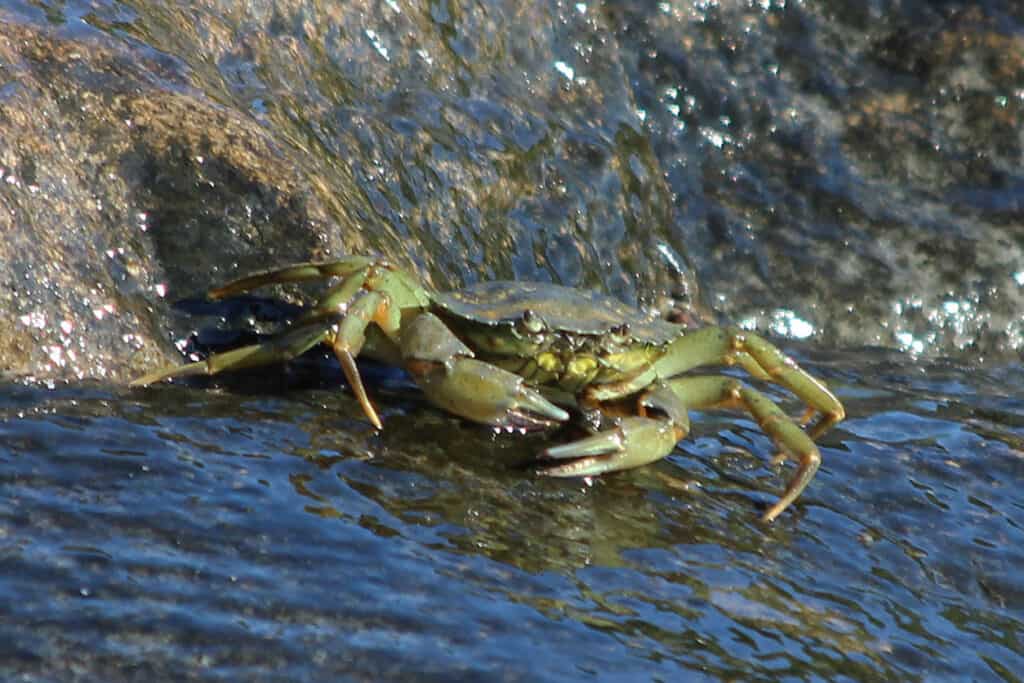Crabbing is exceptionally popular in New York, with novice and professional fishermen pulling crabs out of the water yearly. However, as you might expect, there are many rules and regulations around the crabbing season. Before you decide to head out and catch some crabs, you should understand exactly what the state allows and prohibits. .
In this article, we’ll take a look at everything you need to know about crabbing in New York, including things like bag limits. Of course, you should always check your local regulations, as hunting and fishing regulations can change anytime.
Timing of the New York Crabbing Season

Blue crabs are one of the most popular crab species in New York, so many of the regulations protect them, specifically. For instance, they are one of the few crab species with a minimum size requirement.
©Jen Helton/Shutterstock.com
New York does not have a specific crabbing season. You may take crabs of all species at any time throughout the year, including blue crab and Jonah crab. Crabbers can also take invasive species (in fact, it is illegal to release them after you catch them).
However, certain times are better for catching crabs than others. The state may also suspend crabbing at certain points, depending on environmental factors.
That said, crabs tend to be the easiest to catch when the water warms up. Therefore, you’ll find most people catching crabs during the late spring and summer months. Crabs tend to be abundant near the shores during this time, making them easier to target.
Crabs also migrate somewhere. Blue crabs, one of the most common species in New York, tend to migrate to shallower waters during their breeding season. You may find them, particularly in these warmer waters during this time.
Types of Crabs in New York

The green crab, while not as popular or sought-after as the blue crab, is common in New York.
©iStock.com/bririemoments
There are several different types of crabs in New York. While blue crabs are the most sought-after and common, you may catch other species too.
- Blue Crabs (Callinectes sapidus): Blue crabs are the stars of New York’s crabbing scene. Pretty much everyone that is crabbing in New York targets blue crabs. As you might guess, these crabs have a blue-tinged carapace and distinctive claws. They offer sweet and delicate meat, which makes them a favorite catch.
- Horseshoe Crabs (Limulus polyphemus): While not caught for their meat, it’s common to encounter these crabs in New York. They’re very ancient creatures who play a crucial role in the ecosystem. They have protection in some areas, as they are an important food source for many animals.
- Green Crabs (Carcinus maenas): Green crabs are another common species in New York. They lack the popularity of blue crabs but are commonly caught and harvested for use as bait. They’re known for their extremely voracious appetite, and some areas may consider them invasive.
- Chinese Mitten Crab (Eriocheir sinensis): Chinese mitten crabs are known for being somewhat furry. Many people claim they resemble mittens! They’re an invasive species, so they must be killed once caught.
- Dungeness Crab (Cancer magister): Dungeness crabs attract attention for their large size and excellent meat quality. Although commonly associated with the West Coast of the United States, they can occasionally appear in the waters off of New York.
Bait Crabs
Crabs are not only caught for humans to eat; they also are good bait. Green crabs and mole crabs are the most commonly harvested bait crabs. Green crabs are often favored, as they are very effective at attracting a variety of fish species.
Typically, these crabs are not protected. Therefore, you can catch several each day to use as bait.
New York Crabbing Season Bag Limits and Regulations
There are bag limits and other regulations during the New York crabbing season that are important to keep in mind. These limits help ensure the crab population remains sustainable so that future generations can enjoy them, as well.
Bag limits are the maximum number of crabs you may catch and keep in a single day. These limits exist to prevent overfishing and to maintain a sustainable population. While bag limits can vary somewhat, New York typically has a bag limit of 50 crabs total.
You can check their saltwater fishing regulations for an updated total.
There are also some size limits for crabs. Simply put, this is how big the crab must be before you harvest it. Smaller individuals must go back into the water. These measurements can vary, of course, and sometimes there are several minimums within the same species.
Not all crabs have size limits. Typically, blue crabs and Jonah crabs do have size limits – but other crabs we’ve discussed do not. Remember, invasive species require harvesting when caught, so they do not have a minimum.
Gear and Equipment Regulations
There are many ways to catch crabs, and the regulations may differ from method to method. You cannot simply catch crabs however you’d like. Two of the most common, approved methods are baited handline and dipnet or setting crab traps and pots.
Baited handline and dipnet are a very effective, simple way to catch crabs. A handline is a length of string with bait attached to it. You drop it into the water. When crabs are present, you’ll notice that the line goes tight. Slowly retrieve the line, and when you feel resistance, you can grab the crab with the net!
Crab pots are different. They’re a trap that you bait with an oily fish, like a menhaden or mackerel. Crabs climb into these traps in search of bait. However, due to how the entrance works, they cannot figure out how to get out. Therefore, they’ll stay stuck until you retrieve the catch.
Crab pots also have extra rules and regulations that you have to follow. These rules help protect other wildlife and people.
Most people mark their pot with a buoy, which should be clearly visible and attached to the pot with a sinking line. Buoys must be marked with reflective material. You should also add your contact information, such as your phone number, to the buoy.
Do not set crab pots within 25 feet of a navigational channel, as this may be a hazard for passing boats. You must ensure your crab pot has an escape panel that allows smaller crabs and non-target species to escape.
Sometimes, you will need to include a Terrapin Excluder Device, which is fastened inside each funnel entrance of the crab pot. These reduce the funnel opening to no larger than a few inches, which helps keep turtles out of the pot. Often, getting stuck in one of these traps is fatal for turtles.
You typically need to include these devices when setting up where turtles may be found, such as in creeks and canals.
Blue Crab Tagging Program
The New York State Department of Environmental Conservation runs a blue crab tagging program, which helps them study blue crabs in the area. This program involves tagging blue crabs with yellow wire tags, each with a specific number. They then use these tags to track their movements and behaviors.
If you catch one of these blue crabs, you can contribute to the program when you provide some necessary information. You’ll need to report the 5-digit number on the tag and provide the location and time the crab was caught. This information helps researchers track which crabs end up where.
There is a form available to submit the information online, so it’s pretty easy to do.
After you report the crab, you can either: release the crab with the tag still attached or remove the tag and harvest the crab as usual. You do not have to avoid harvesting these crabs. (In fact, doing so would prevent researchers from getting the information they need.)
The main objective of the Blue Crab Tagging Program is to tag fully grown female blue crabs and male blue crabs that are at least five inches long. The program selects these crabs to tag since they are less likely to molt, which is necessary for monitoring their development and behavior.
The photo featured at the top of this post is © MeliaMuse/iStock via Getty Images
Thank you for reading! Have some feedback for us? Contact the AZ Animals editorial team.






